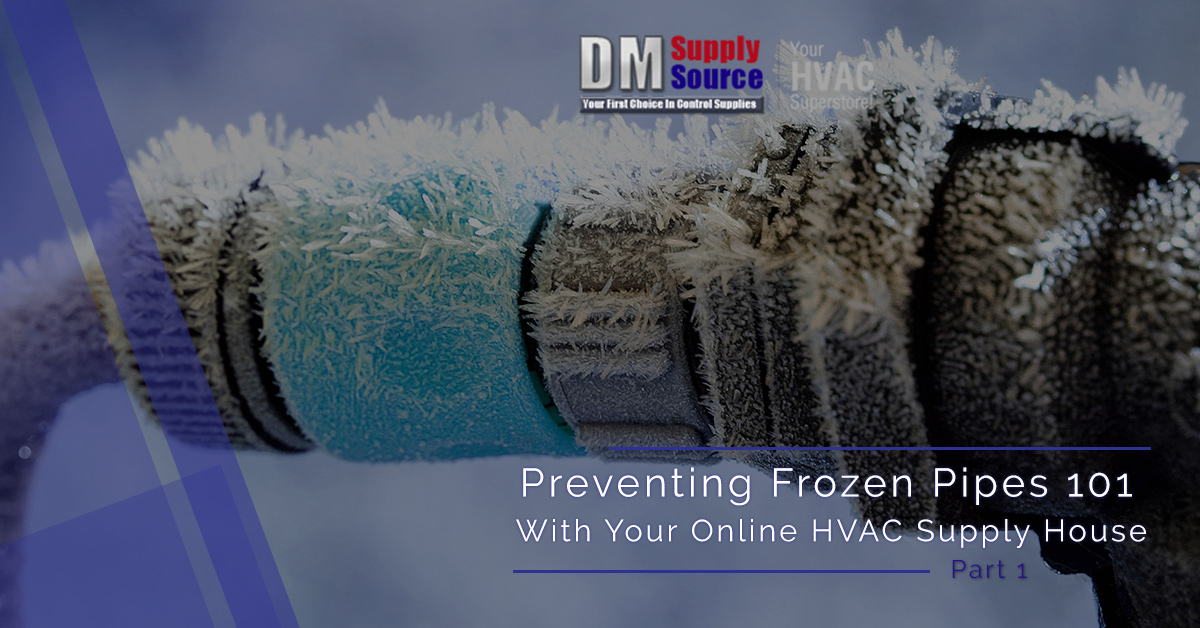Preventing Frozen Pipes 101 With Your Online HVAC Supply House Part 1
Jan 8th 2018

As the new year comes into full swing, the winter weather is out in full force across the country. Whether you’re a homeowner without an arsenal of knowledge or an HVAC technician with years of experience, it’s important to take the proper steps to keep the pipes in your home safe during the freezing season. If you are in need of name brand HVAC supplies, DM Supply Source can help! Our HVAC supply house provides thousands of products online that are in stock and affordably priced. Our online AC supply store features quality equipment that can ship the same day with free shipping when you spend at least $750. From pneumatic controls to safety products, we’re proud to provide all of the heating and cooling supplies needed to correct a variety of issues for clients with a wide range of equipment.
Our HVAC products are made to be the best in the industry, but even they are sometimes no match for the frigid winter cold. Today, we’ll discuss a few tips that may prove helpful in preventing frozen pipes in you or your customer’s home. When done, be sure to shop our wide range of HVAC parts online to find the equipment you need!
Frigid Concerns
Cold temperatures can cause the pipes in your home to freeze up, creating a myriad of problems that can be disruptive to your home comfort and wallet. Freezing pipes can clog, expand, and crack, creating serious concerns for your property. A ⅛ inch crack in one of your lines, for example, can lose upwards of 250 gallons of water a day! This onslaught of moisture can flood your home, compromise its structural integrity, and even create serious concerns and hazards with mold. Houses in all types of climates with all manners of pipe materials can suffer from frozen pipes, making it essential to take the proper steps to protect your water and sewer lines from the worst.
Proactive Tasks
Freezing pipes may be a nightmare for many homeowners, but actions can be taken beforehand to prevent potentially disastrous results. In most cases, poor insulation, sudden temperature changes, and thermostat issues can be to blame. In order to avoid frosty complications, be sure to:
- Insulate your pipes. Freezing temperatures can be very damaging to exposed lines, making it a necessary to complete the simple and effective task of insulating the pipes throughout your home. Lines in your attic, crawl space, and basement often require the most attention, as these areas are more susceptible to temperature fluctuations.
- Products such as heat tape can also be used for pipes that need extra protection. Be sure to follow instructions for these products carefully to avoid any costly consequences.
- Inspect for drafts. Cold drafts can severely hamper the warmth of your home’s pipes. Before winter is in full effect, be sure to inspect your home for leaks that allow cold air to infiltrate. Take special care to seal out problem areas that are in close proximity to any water or sewer pipes. Homeowners who invest their time into plugging up any weak points in the home will be rewarded with warmer pipes and an improved utility bill.
- Disconnect exterior lines. Before the season’s first freeze, it’s important to unhook garden hoses and any other tools that require moisture. It is also recommended to properly drain your sprinkler system, as leftover water in the lines can freeze and cause problems. Any icing that occurs on the exterior of your home has the potential to spread inward, causing issues to interior pipes.
Keep the Home Heated
One common cause of frozen pipes is the act of lowering or turning off the heat when you’re out of town. Homeowners have also been known to lower the heat when they go to bed which, while cost-effective, may be too risky for comfort. If the temperature in your house drops, the ambient warmth surrounding your pipes will begin to quickly dissipate. Homes that are heated properly may also struggle when the temperature dips quickly. Generally, it is recommended to keep the house heated to at least 55 degrees Fahrenheit to avoid any plumbing headaches. If you are planning on leaving your house, be sure to leave the heat on. You may not save on your energy bill this month, but the health of your pipes will be left intact.
As the freezing weather continues to rage outside, many HVAC technicians are out and hard at work to ensure that families are safe and warm during the worst weather. Next time, we’ll continue this blog by concluding the importance of insulating your home’s pipes in addition to how our full lineup of HVAC supplies can help. Anyone in need of an HVAC supply store can benefit from shopping with DM Supply Source. With over 150,000 products in stock and expert advice, our company is here and ready to help your operations. Contact us with questions or search now to find the equipment you need!

